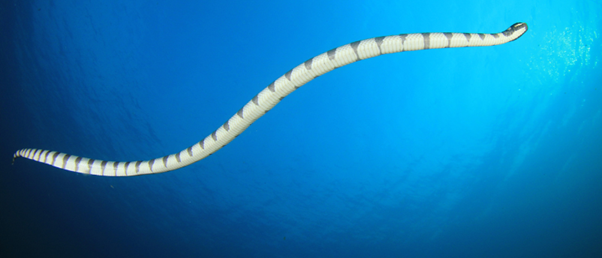Sea snakes regain color vision through gene duplication

Snakes lost their color vision many millennia ago, but one species of sea snake has regained these genes.
The earliest snakes lost much of their ability to see color as they inhabited dimly lit spaces. Now, a collaboration of researchers from The University of Adelaide (Australia), The University of Plymouth (UK) and The Vietnam Academy of Science and Technology (Nha Trang) have found a species of sea snake that has enhanced its color vision through gene duplication.
Approximately 400 million years ago prehistoric fish came ashore and began the evolutionary lineage life on land descends from. While most of us stayed on solid ground, the annulated sea snake underwent a second evolutionary transition, returning to the sea. They inhabit the waters surrounding Australia and Asia.
The researchers of this study compared visual opsin genes of five ecologically distinct snakes from the Elapidae family, which the annulated sea snake is part of, using previously published reference genomes. Opsins are photoreceptor molecules that allow us to see. As animals adapted to new habitats, many lost opsins over their genealogical history, but finding examples of those that have regained opsins is incredibly rare.
 Researchers dissscover broadly neutralizing antibody against snake neurotoxins
Researchers dissscover broadly neutralizing antibody against snake neurotoxins
Researchers have found a new human monoclonal antibody that can neutralize snake neurotoxins across species and geographies.
This study revealed that the annulated sea snake has four intact copies of the short wavelength sensitive opsin 1 (SWS1) gene, of which two have ancestral UV sensitivity and two have sensitivity to longer wavelengths that are prominent in ocean habitats. When these genes were regained, and then duplicated, remains unknown.
In 2020, evidence of color vision in the annulated sea snake was published. It was initially thought that this visual adaptation was due to gene polymorphism, genetic variations that occur in different forms among individuals of the same species; however, this study revealed that it’s actually a result of gene duplication, a major mechanism that introduces new genetic material during molecular evolution.
“With polymorphism, it’s a bit of a lottery – only some individuals would have that extended color sensitivity. But now we know that there are multiple gene copies, which have diverged, so color vision is expected to be seen in all members of these species,” explained first author Isaac Rossetto (University of Adelaide).
To find the origins of and mechanisms underlying this evolutionary gain in color vision, further genomic, neuroanatomical and behavioral investigations are necessary.
Rossetto commented, “it’s quite unique and interesting that these snakes appear to be gaining and diversifying their opsins when other land-to-sea transitioned animals have done the opposite.”





